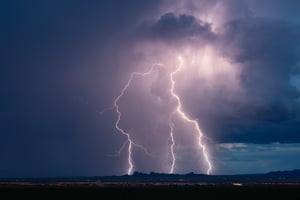
Spring will soon be here – and with spring comes the risk of renewed severe weather and fire safety risks.
A comprehensive emergency plan is essential to ensuring your employees' well-being during severe weather or fire events. This plan should include detailed safety procedures and protocols that all staff members must follow to maintain safety effectively.
In this blog, we’ll walk you through some critical steps you can take to prepare your team and minimize risks.
Develop a Comprehensive Emergency Plan
Create a detailed emergency plan that outlines the procedures to follow in the event of severe weather or a fire. The plan should include evacuation routes, meeting points, and communication protocols. Review the plan with your staff regularly and conduct drills to ensure they are familiar with the procedures. Regularly evaluate the effectiveness of your emergency plan, make improvements as needed, and keep employees updated on any changes or updates to the emergency plan.
Train Staff on Severe Weather and Fire Safety
Organize training sessions to educate staff about the different types of severe weather and fire hazards they may encounter. Train them to recognize warning signs, take appropriate action, and use safety equipment. Develop specific emergency procedures for different types of severe weather, such as tornadoes and floods, and guide staff on how to stay safe during these events. You can work with your chosen fire and life safety company regarding how frequently drills need to be performed.
Establish an Emergency Notification System
Set up a reliable emergency notification system to alert staff about impending severe weather or fire emergencies. To ensure everyone receives timely notifications, utilize multiple communication channels, such as email, text messages, and alarms. Establish a partnership with local emergency services, such as the fire department and emergency management office, and inform them of your emergency plan.
Provide Emergency Supplies
Stock emergency kits in designated locations throughout the workplace, including first aid supplies, food, water and flashlights. Ensure that fire extinguishers are readily available and adequately maintained.
Conduct Regular Safety Inspections
Have regular safety and maintenance inspections in the workplace for potential fire hazards, such as blocked fire exits, electrical hazards, and flammable materials. Address any identified hazards promptly to minimize risks. Depending on what type of organization you are, the timeline for inspections will vary. Be sure to look up the codes specific to your industry or worked with a professional fire and life safety team to ensure you’re kept in compliance and as safe as possible when it comes to maintenance.
Ensure Proper Fire Protection Measures
Install and maintain fire alarm systems, sprinklers, and smoke detectors throughout the workplace. To ensure proper functioning, have these systems regularly tested and inspected as mandated by fire safety codes. You may also need very specific types of equipment in different parts of your building, depending on the particular fire risks or equipment involved. A fire and life safety company such as CertaSite can help make sure you have the proper protection, whatever your needs.
Establish a Smoke-Free Policy
Implement a strict smoke-free policy to reduce the risk of fire ignition and ensure a healthier work environment. Enforce the policy consistently and provide designated smoking areas outside and away from the building. This can help reduce your risk of accidental fires from ashes or cigarettes that aren’t fully extinguished.
By taking proactive measures and preparing your staff for severe weather and fire safety risks, you can help ensure their safety and reduce the potential impact of these emergencies on your organization. Better yet, work with a trusted fire and life safety company like CertaSite, which will go beyond compliance to protect your people and property as much as possible.

